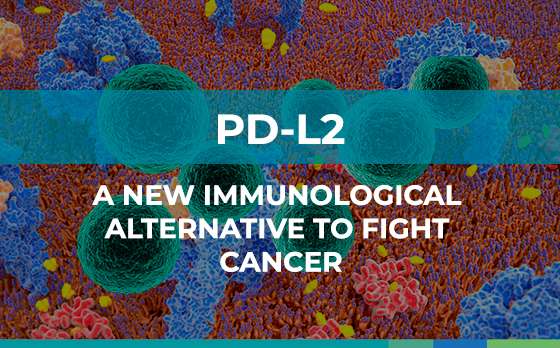The PD-1/PD-L1 immune checkpoint plays a crucial role in maintaining immune tolerance by controlling immune cell activity and proliferation, but it also enables cancer cells to evade immune detection by overexpressing PD-L1. Targeting PD-1 and PD-L1 in immunotherapy has yielded successful treatments for various cancers, including melanoma and non-small cell lung cancer. A lesser-known ligand, PD-L2, has attracted limited attention despite having a higher affinity for PD-1 and expression in several cancers, such as triple-negative breast cancer and head and neck squamous cell carcinomas.
PD-L2 can significantly modulate immune responses, particularly by enhancing the immunosuppressive microenvironment via cancer-associated fibroblasts. Unlike PD-L1, PD-L2 binds uniquely to the receptor RGMb, present on CD8+ T cells, contributing to immune evasion. PD-L2 expression is induced by cytokines like IFN-γ and IL-4 and can be upregulated in response to chemotherapy agents like cisplatin and radiation.
a study carried out by Chaib et al. (2024), at the Institute for Research in Biomedicine of Barcelona, investigates the role of PD-L2 in therapy-induced senescence (TIS), a state of stable cell cycle arrest induced by treatments like chemotherapy and radiation. For this purpose, modified mice were used and maintained under controlled conditions to observe tumor progression in a realistic biological environment. In parallel, human and animal cells were cultured in sterile environments in order to replicate the tumor environment in a controlled manner. To induce cellular aging, specific drugs were applied, which allowed us to study how these aged cells respond to different experimental treatments.
Gene activity was analyzed by PCR, a technique that allowed changes in key cancer-related genes to be observed, providing valuable information on the impact of treatments at the molecular level. Staining techniques were also used to visualize specific markers in the cells, facilitating the identification of cancer-associated proteins in specific cell types. Through flow cytometry, cancer cells were identified and analyzed according to certain markers, which provided precise data on their molecular profile and particular characteristics.
Finally, the CRISPR gene editing technique was used to eliminate the PD-L2 gene in some cells, allowing the role of this gene in cancer development and progression to be studied. These combined methods offer a comprehensive perspective of the impact of treatments on tumor cells and tissues, advancing the understanding and possible therapeutic approaches against cancer.

Figure 1. Illustration showing both scenarios of the experiment, on the one hand (left) the PD-L2 gene in a senescent cancer cell is shown to be highly expressed, causing the RGMb receptors of CD8+ T cells (immune cells) to interact with PD-L2 and inhibit their response, On the other hand (right), the researchers genetically deleted PD-L2 from senescent cancer cells, and observed that there was no RGMb-PD-L2 interaction, so no inhibition occurred and the immune response was effective, destroying the tumor cells (Image made with BioRender).
Although senescence halts cancer cell growth, the associated secretory phenotype (SASP) releases pro-inflammatory factors that can promote tumor growth indirectly by attracting immunosuppressive cells. Senolytic therapies, which target senescent cells, have been shown to enhance cancer treatment efficacy. This research highlights that PD-L2, not PD-L1, is significantly upregulated in senescent cancer cells, creating a unique immunosuppressive signature that hinders immune cell activity, particularly affecting CD8+ T cells recruitment post-chemotherapy.
Experiments demonstrated that knockout of PD-L2 in cancer models improved the response to chemotherapy, reducing tumor growth and enhancing immune surveillance by reducing immunosuppressive cell recruitment. This emphasizes PD-L2’s pivotal role in supporting senescent cell persistence and immunosuppression in tumors, suggesting that anti-PD-L2 therapies could be a promising adjunct to conventional cancer treatments, potentially improving outcomes in tumors resistant to therapies targeting only PD-1/PD-L1.
Main Reference: Chaib, S., López-Domínguez, J. A., Lalinde-Gutiérrez, M., Prats, N., Marin, I., Boix, O., García-Garijo, A., Meyer, K., Muñoz, M. I., Aguilera, M., Mateo, L., Stephan-Otto Attolini, C., Llanos, S., Pérez-Ramos, S., Escorihuela, M., Al-Shahrour, F., Cash, T. P., Tchkonia, T., Kirkland, J. L., Abad, M., … Serrano, M. (2024). The efficacy of chemotherapy is limited by intratumoral senescent cells expressing PD-L2. Nature cancer, 5(3), 448–462. https://doi.org/10.1038/s43018-023-00712-x
Other references
Cha, J. H., Chan, L. C., Li, C. W., Hsu, J. L., & Hung, M. C. (2019). Mechanisms Controlling PD-L1 Expression in Cancer. Molecular cell, 76(3), 359–370. https://doi.org/10.1016/j.molcel.2019.09.030
Coppé, J. P., Desprez, P. Y., Krtolica, A., & Campisi, J. (2010). The senescence-associated secretory phenotype: the dark side of tumor suppression. Annual review of pathology, 5, 99–118. https://doi.org/10.1146/annurev-pathol-121808-102144
Ruhland, M. K., Loza, A. J., Capietto, A. H., Luo, X., Knolhoff, B. L., Flanagan, K. C., Belt, B. A., Alspach, E., Leahy, K., Luo, J., Schaffer, A., Edwards, J. R., Longmore, G., Faccio, R., DeNardo, D. G., & Stewart, S. A. (2016). Stromal senescence establishes an immunosuppressive microenvironment that drives tumorigenesis. Nature communications, 7, 11762. https://doi.org/10.1038/ncomms11762
Xiao, Y., Yu, S., Zhu, B., Bedoret, D., Bu, X., Francisco, L. M., Hua, P., Duke-Cohan, J. S., Umetsu, D. T., Sharpe, A. H., DeKruyff, R. H., & Freeman, G. J. (2014). RGMb is a novel binding partner for PD-L2 and its engagement with PD-L2 promotes respiratory tolerance. The Journal of experimental medicine, 211(5), 943–959. https://doi.org/10.1084/jem.20130790


